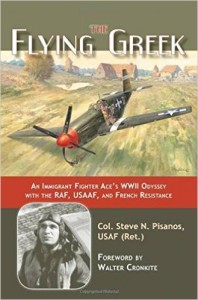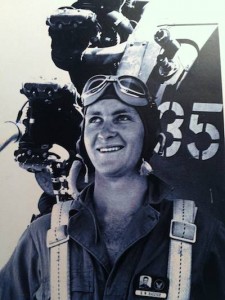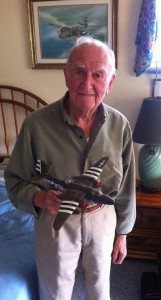Independence Day Perspective from WWII Vets
Independence Day 2023
Use controls above or click here to open this Hometown Heroes podcast in a new window
Episode #792 of Hometown Heroes, airing July 1-6, 2023, puts Independence Day in perspective through the memories of three World War II veterans: Sam Terasaki, Steve Pisanos, and Karl Haeuser.
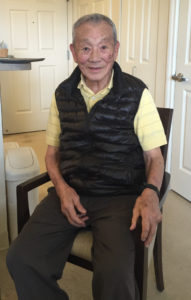
100th/442nd veteran Sam Terasaki
Terasaki was one of more than 33,000 Americans of Japanese ancestry to serve in World War II. You’ll hear about some of the close calls he survived as a mortarman with the 100th Battalion/442nd Regimental Combat Team during the final month of the war in Europe.
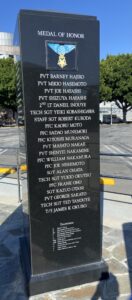
The Go For Broke National Monument in Los Angeles displays the names of the Nisei veterans awarded the Medal of Honor.
The first Nisei soldier to be awarded the Medal of Honor was Sadao “Spud” Munemori, was a friend of Sam’s. In fact, Terasaki had spoken to Munemori just before the heroics that would make his friend “Spud” a posthumous recipient of our nation’s highest military decoration. You’ll hear Sam’s reflections on Munemori and other men who carried his admiration and respect. Initially classified as “4C, Enemy Alien” and not allowed to serve, Terasaki experienced quite the contrast with his unit upon returning from overseas duty. Greeted outside the White House by President Harry Truman, Sam and other members of the 442nd watched as a Presidential Unit Citation was added to the “Go For Broke” unit’s regimental colors. The response Terasaki often employed when asked if he was Japanese is one that resonates this Independence Day.
“I want America to know what we did during the war,” Terasaki told Hometown Heroes in 2017. “That we’re Americans just like anyone else who was born here, even though we look different.”
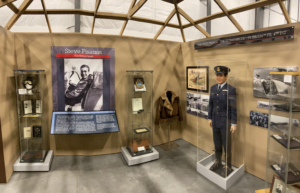
The display honoring Steve Pisanos at the National Museum of WWII Aviation.
The pride Steve Pisanos took in being an American is something that found its way into just about every conversation he had about his service in World War II. A native of Athens, Greece, he became a merchant seaman, eventually getting off of a ship in Baltimore and earning a private pilot’s license in New York before military service gave him the chance to become a U.S. citizen. Pisanos, who shared his story on episode #407 of Hometown Heroes in 2016, first flew Spitfires in a Royal Air Force Eagle Squadron before piloting American planes with the 4th Fighter Group.
The cover of his book, “The Flying Greek,” depicts the scene on March 5, 1944, when Pisanos had to crawl out on the wing of his P-51 to survive a crash landing.
“I shot down three of the guys there, and of course, on the way back, I lost my engine,” he said of a dogfight with Luftwaffe pilots. “I decided not to bail out at high altitude because the Germans were really shooting at anybody coming down in a parachute.”
Listen to Hometown Heroes for his account of how he survived that chaotic day, not to mention those that followed, and for his unwavering support of his “adopted country,” which he called “the greatest in the world.”
The final veteran whose memories you’ll hear on this Independence Day edition of Hometown Heroes is Karl Haeuser, who had his perspective on freedom shaped by the time he spent in the absence of freedom as a prisoner of war. An aerial gunner with the 410th Bomb Group’s 644th squadron, Karl survived being shot down in his A-20 Havoc on August 4, 1944. Haeuser first shared his story on episode #280 of Hometown Heroes in 2013, illuminating his death-defying P.O.W. journey that began when his parachute came down right near the anti-aircraft battery that had blown the tail off of his plane.
“We didn’t have any idea how the Germans were going to treat us or mistreat us,” you’ll hear Haeuser recall. “But they did not mistreat us. The only thing they didn’t do: they didn’t feed us.”
His experience in captivity was lacking in food, but not in humor. You’ll hear about what unexpected item Karl and his fellow prisoners used to mock Adolf Hitler in their prison camp, another material they tried to fashion into ice skates, and what it took to survive an 88-day death march triggered by approaching Russian forces.
“I never did even think that I wasn’t gonna make it because of my faith in God,” Haeuser explained. “I knew he was gonna take care for me.”
He had to wear the same clothes for three months, walking in very uncomfortable shoes after he had traded his government issued “G.I.” shoes for a can of spam. You’ll the unusual use he and his fellow prisoners found for manure on the march, and what happened to those who were unable to continue marching. Haeuser lost more than 50 pounds in captivity, shrinking down to roughly 90 pounds by the time he finally tasted freedom again.
“An American jeep, with a soldier in the jeep,” you’ll hear him remember of the scene that signaled to him that he was once again a free man. “We just stood there and cried. Grown men. I’ll never forget that.”
#FreedomIsNotFree
—Paul Loeffler




